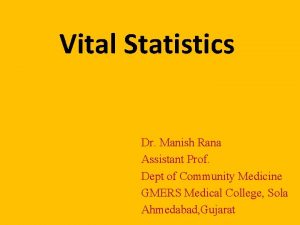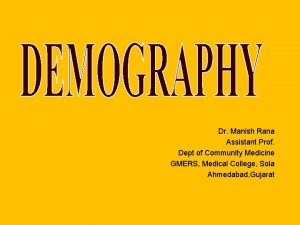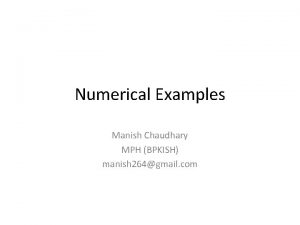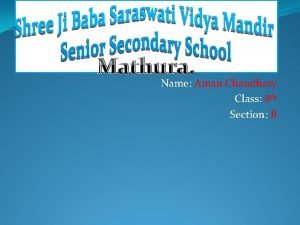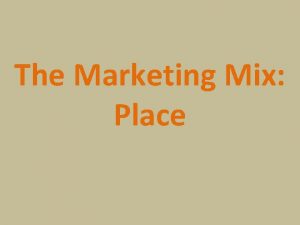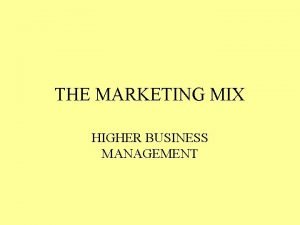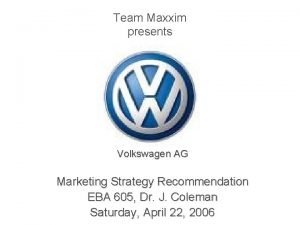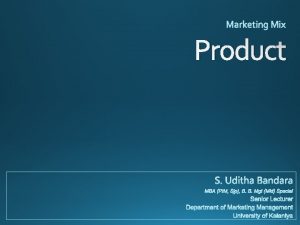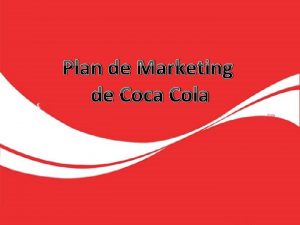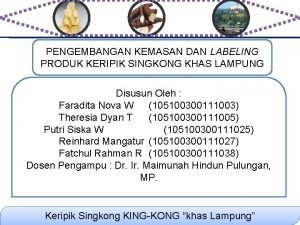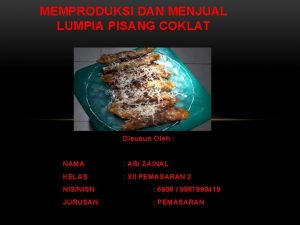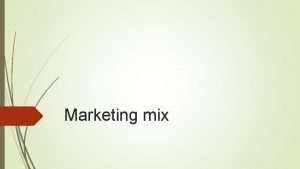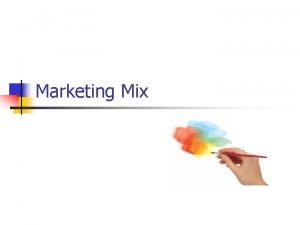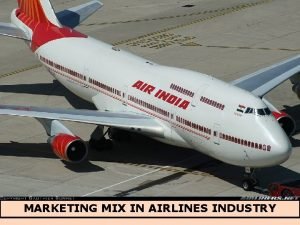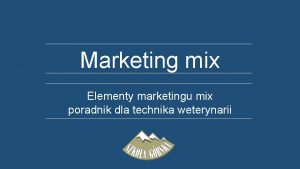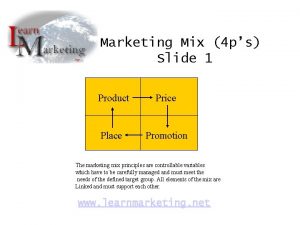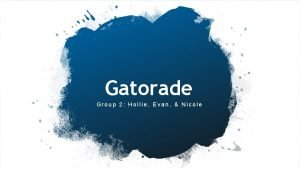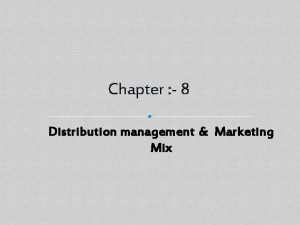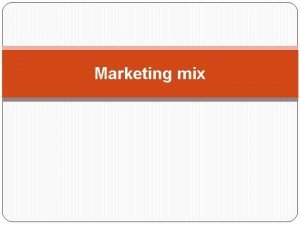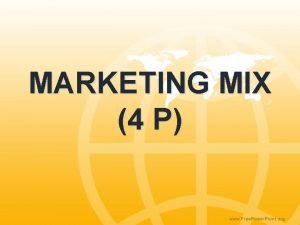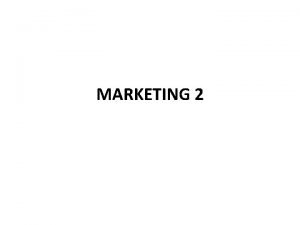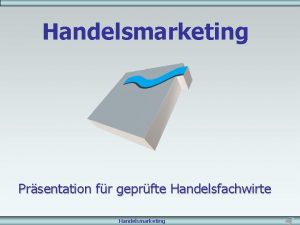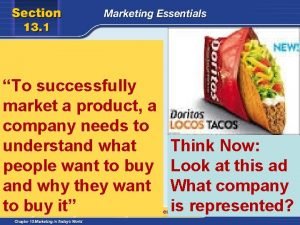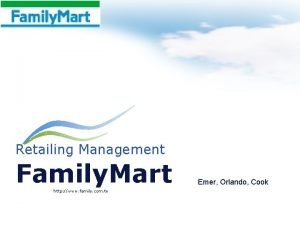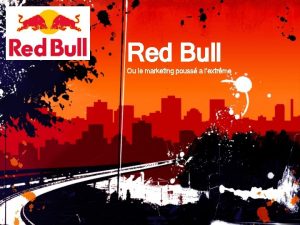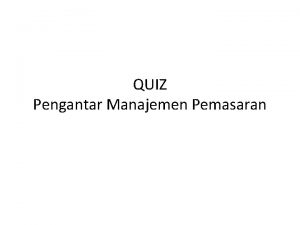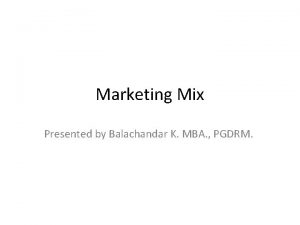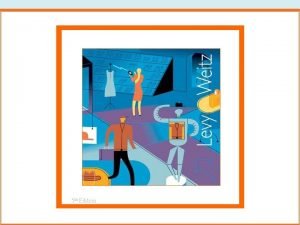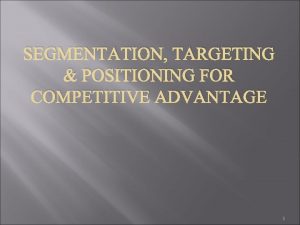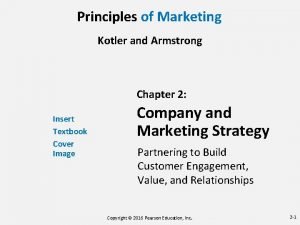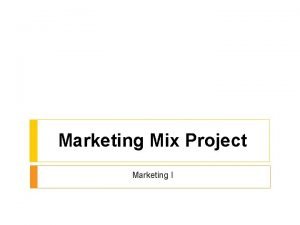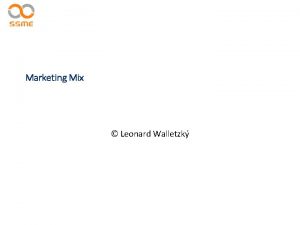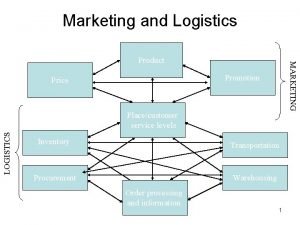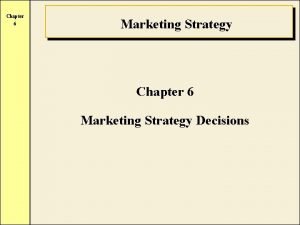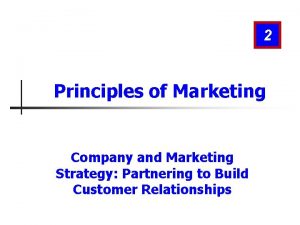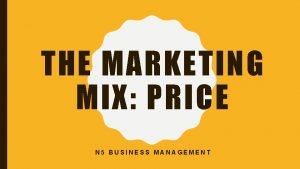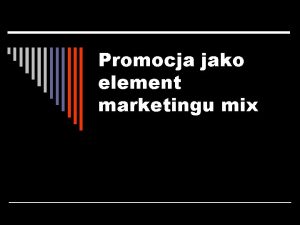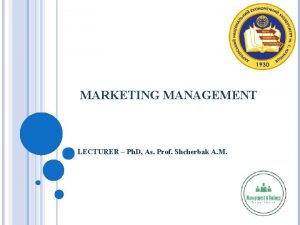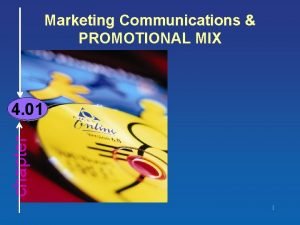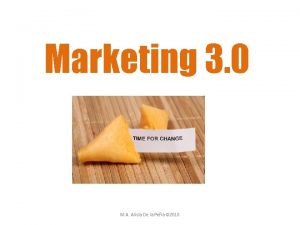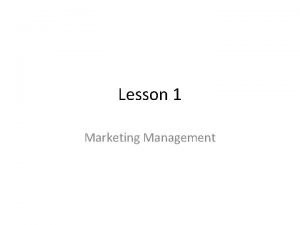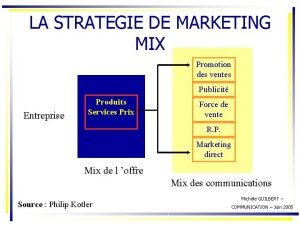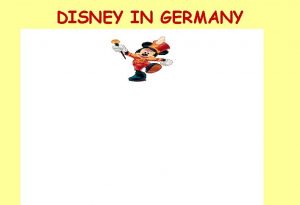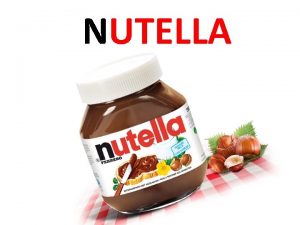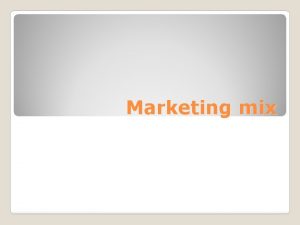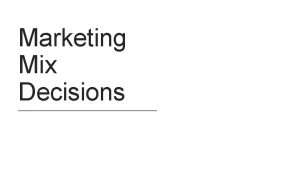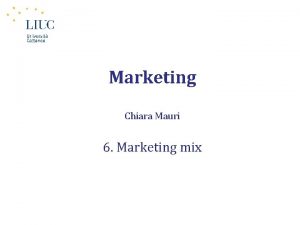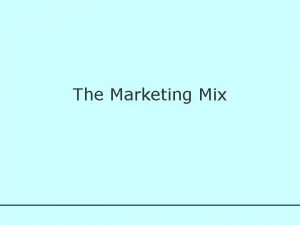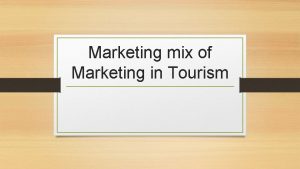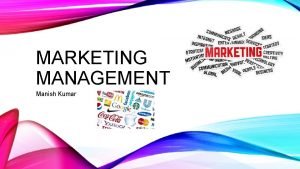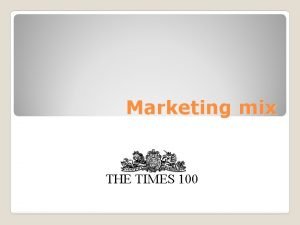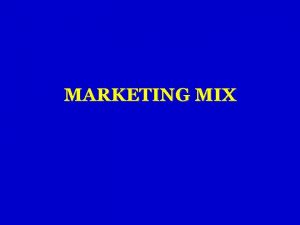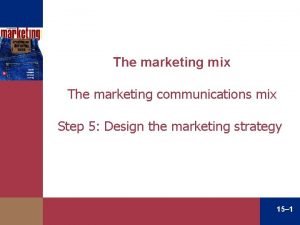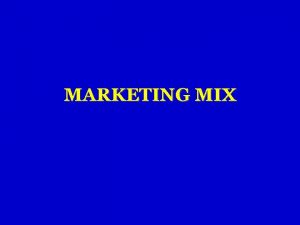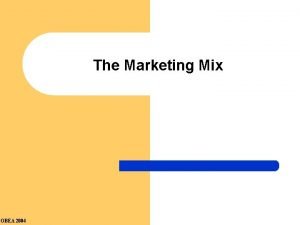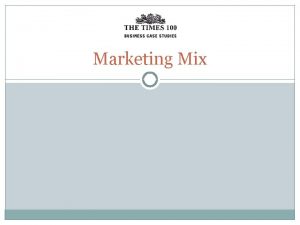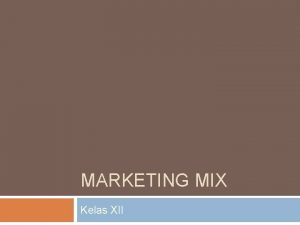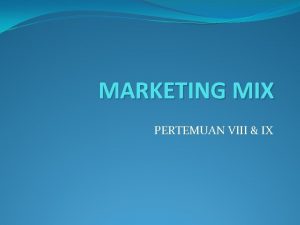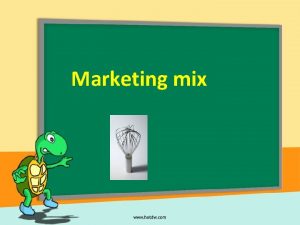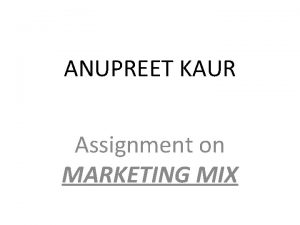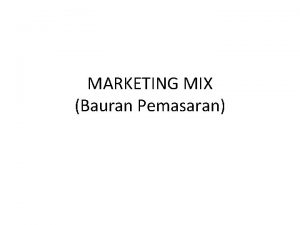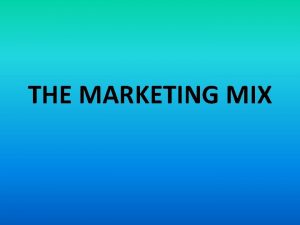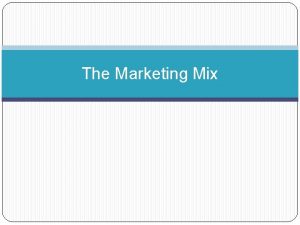MARKETING MIX MANISH KUMAR IN THIS UNIT YOU





































































- Slides: 69

MARKETING MIX MANISH KUMAR

IN THIS UNIT YOU WILL READ ABOUT • Product : Product Mix, New Product development, levels of product, types of product, Product life cycle, Branding and packaging. • Distribution : Concept, importance, different types of distribution channels etc.

THE MARKETING “MIX”

PRODUCT • A product is a set of tangible and intangible attributes including packaging, colour, price, quality and brand plus the service and reputation of the seller. A product may be a tangible good, service, place, person or idea. W. J. Stanton • Everything the purchaser gets in exchange for his money C. P. Stephenson

A PRODUCT IS MORE THAN JUST A PRODUCT Color Product quality Product warranty Product Packagi ng Price Brand

COMPONENTS OF PRODUCT Symbolic Product Augmente d Product Core Product

PRODUCT MIX • A company’s product mix (also called product assortment) is defined as the set of all product lines and items that a particular seller offer for sale to buyers. • A company’s product mix can be described as having a certain width, length, depth, and consistency. • Avon’s product-mix consists of three major product lines: cosmetics, jewelry, and household items. Each product line consists of several sublines • Example: cosmetics break down into lipstick, powder, and so on. • All together Avon’s product mix includes 1, 300 items. A large supermarket handles as many as 10, 000 items, General Electric manufactures as many as 25, 000 items.

PRODUCT MIX WIDTH AND PRODUCT LINE LENGTH SHOWN FOR P&G

• width - how many different product lines the company carries • length - the total number of items in its product mix. • depth - how many variants are offered of each product in the line. • consistency - how closely relate the various product lines are in end use, production requirements, distribution channels or some other way. • The four dimensions of the product mix provide the handles for defining the company’s product strategy. • Product-mix planning is largely the responsibility of the company’s strategic planners. They must asses, with information supplied by the company marketer’s, which product lines to grow, maintain, harvest and divest.

TYPES OF PRODUCT Based on nature Based on consumer intentions Based on social benefit

BASED ON THE NATURE • • • Goods Services Ideas Experiences Events Persons Places Properties Organisations informations

BASED ON CONSUMER INTENTIONS Consumer Product Industrial or Business Product

CONSUMER PRODUCTS • Convenience Products: The consumer goods which a customer usually purchases frequently and wants immediately and with minimum of efforts are called convenience goods. • Shopping Goods: These goods are bought by the customer only after comparing quality, price suitability and style. • Speciality Goods: They are consumable products which can only be purchased from specialist retailers and which consumer select deliberately. • Unsought Products: Unsought products are those products about which potential buyers do not know that they exist or do not want to purchase. • Regularly Unsought Products: There are existing products that consumers do not want now, although they may eventually purchase them. • New Unsought products: Products that are totally new and unfamiliar to consumers are new unsought products.

INDUSTRIAL GOODS • A product bought for use in the production of other or in an organisational operation is an industrial product. • Raw material • Capital equipment • Accessory equipment • Component parts • Supplies • Industrial services

BASED ON SOCIAL BENEFITS • Pleasing Products: These give high imeediate satisfaction, but do harm to consumers in long run • Deficient Products: These have neither immediate appeal nor long run benefits • Salutary products: They have long run advantages but have no immediate appeal to consumers. Hence, firms are not primarily interested in such products. • Desirable Products: They have a happy combination of high immediate satisfaction and high long run consumer welfare.

FACTORS INFLUENCING CHANGE IN PRODUCT MIX • Change in market demand • Cost of production • Quantity of production • Advertising and distribution factors • Use of residuals • Change in company desire • Competitors actions and reactions • Change in purchasing power

PRODUCT MIX STRATEGIES • Product line expansion/contractions • Product modification • Product elimination

NEW PRODUCT DEVELOPMENT

NEW PRODUCT DEVELOPMENT • Product development encompasses the technical activities of product research, engineering and design

NEW PRODUCT DEVELOPMENT • A product may be new to company but not new to the customers or the product may be new to customers but not to the company. • Booz, Allen and Hamilton identified six categories of new product in terms of their newness to the company and to the marketplace. • New to the world: New products that create an entirely new market • New product lines: New prodyct that allows a company to enter an established market for the first time • Additions to the existing market: new products that supplement a company’s established product line. • Improvements or revision to existing product: new products that provide improved performance or greater perceived value and replace existing products • Repositioning: existing products that are targeted to new markets or market segment • Cost Reductions: New products that provide similar performance at lower cost.

FACTORS CONTRIBUTING TO NEW PRODUCT DEVELOPMENT • Changing customer preferences. • Technological Changes. • Government Policy. • Product life cycle.

etin g Co on mme pro launc rcializ duc hin ati g th t e ark t. M Tes Pro Ma duct De rketin and vel opmg Mix ent Bu An sines aly s sis Ma stra rketin De tegy g vel opmand ent Co De ncept and velop Tes men ting t n atio ene r een ing Scr a. G Ide NEW PRODUCT DEVELOPMENT PROCESS

BENEFITS OF NEW PRODUCT DEVELOPMENT • Products introduced on time • Higher Productivity • Lower project costs • Greater revenue from new products

CHALLENGES IN NEW PRODUCT DEVELOPMENT • • • Innovative imperative New product success New product failure Weakness in distribution Inadequate salesforce Insufficient marketing efforts Competition Poor timings Higher costs Product defect

PRODUCT LIFE CYCLE

PRODUCT LIFE CYCLE • The product life cycle is an attempt to recognise distinct stage in the sales history of the product. Philip Kotler • The life cycle of a product has many points of similarity with the human life cycle; the product is born, grows lustily, attains dynamic maturity then enters its declining

PHASES OF PRODUCT LIFE CYCLE Decline Maturity Growth Introduction

PRODUCT LIFE CYCLE STRATEGIES • Introduction phase: This phase of characters arising out of inefficient production level by high operational costs. Rapid Skimming Strategy Slow Skimming Strategy Rapid Slow Penetration. Strategy gy

GROWTH PHASE • Improves product quality • Add new product features and improved styling • Enter into new market segment • Reduce the prices to attract customer • Increase promotional activities

MATURITY • Improve quality • Give proper attention to increase the usage among the current customer • Try to convert non-users into user of the product • Try to discover new uses of the product

DECLINE • Improve product in functional sense • Make sure that the marketing and production programme are as efficient as possible • Streamline product assortment

FACTORS AFFECTING PLC • Rate of technical change • Rate of man at acceptance • Ease of competitive entry • Risk bearing capacity

UTILITY OF PRODUCT LIFE CYCLE • As a forecasting tool. • As a planning tool. • As a control tool. • Development of new products.

BRANDING

BRANDING • The term ‘branding’ refers to the entire process in creating a unique name and image for a product (good or service) in the consumers’ mind, through advertising campaigns with consistent theme.

CHARACTERISTICS OF SUCCESSFUL BRANDS • Superior product quality • Additional services • Differentiation from competition • Pioneers in a way

FUNCTION OF BRAND To Consumer s To Manufacture rs

TO CONSUMERS • Identification of source of product. • Assignment of responsibility to product maker. • Risk reducer. • Search cost reducer. • Promise, bond or deal with maker of product. • Symbolic devise. • Signal of quality.

TO MANUFACTURERS • Means of identification to simplify handling or tracing • Means of legally protecting unique features • Signal of quality level to satisfied customers • Means of endowing products with unique associations • Source of competitive advantage • Source of financial returns.

BRAND LEVELS Attribute Brands Emotional Brands Benefit Brands Value Brands

FACTOR TO BE CONSIDERED IN BRANDING • Quality • Repositioning • Positioning • Communications • First Mover advantage • Long term perspective internal marketing

SIGNIFICANCE OF BRANDING • Easy to advertise. • Easy to identify the products. • Creation of separate market. • To get more price. • Easy to expand the product mix. • Personal contact with consumers.

SIGNIFICANCE TO MIDDLEMEN • Easy to understand the needs and wants of consumers • Less risk • No need of advertsiment and sales promotion • Increase in sales • Increase in profits • Increase in goodwill

SIGNIFICANCE TO CONSUMER • Easy to recognise • Availability of quality products • Minimum fluctuations in price • Improved packaging • Mental satisfaction

PACKAGING

PACKAGING • Packing means wrapping of goods before they are transported or stored or delivered to a consumer. • Packaging has been defined as an activity which is concerned with protection, economy, convenience and promotional considerations. • Packaging may be defined as the general group of activities in product planning which involves designing and producing the container or wrapper for a product.

PURPOSE OF PACKAGING • Product protection • Product attractiveness • Product convenience • Segmentation • New product planning • Self service and supermarket • Reusable recyclable • Product constraint • Product identification • Effective sales tool • Retail marketing trends • Increase marketing

FUNCTIONS OF PACKAGING Communicatio n function Profit Function Utilitarian function Purchase and marketing function

UTILITARIAN FUNCTION • It helps in easy brand identification • It enhances product use convenience by keeping it clean and undisturbed • Package protects products from deterioration, spilling, spoilage and evaporation during its transit from manufacturer to consumer • It makes product handling easier and safe on the retail store shelves.

PROFIT FUNCTION • Effective package cuts costs of handling and transportation and protects product from damage, thereby, saving a company from cuts in profits • Consumers assigning relatively higher value to package are usually prepared to pay higher price for this product attribute. As a result, higher contribution to profit flows from package.

COMMUNICATION FUNCTION Attractivenes s of product Promote Products Communicate and Product message Identification and differentiatio n

PURCHASE AND MARKETING FUNCTION 1. At the other end of the chain packaging is a part of marketing and must be considered at the start of any marketing plan. 2. It will be seen that the packaging function is involved with many other functions within the company. 3. Efficient communication are important because of the diverse disciplines represented in the packaging operation.

TYPES OF PACKAGING Consume r Package Transit Package Multiple Package Types of packagin g Family Package Re-Use Package

FACTORS INFLUENCING PACKAGING DECISION Physical Characteristic s Economy Convenience Miscellaneou s Factors

DISTRIBUTION CHANNEL

DISTRIBUTION CHANNEL • Channel of distribution is a path traced in the direct or indirect transfer of the title to a product as it moves from a producer to ultimate consumers or industrial consumers • A channel of distribution or marketing channel is a structure of intra-company organisation, units and intra company agents and dealers, wholesalers and retailers through which a commodity product or service is marketed.

CHARACTERISTICS OF CHANNEL OF DISTRIBUTION • Route or pathway • Flow • Composition • Remuneration • Time utility • Convenience value • Possession value • Marketing tools • Supply demand linkage

OBJECTIVES OF DISTRIBUTION CHANNELS • To make the product readily available to the market consumers at which it is aimed. • To enhance the prospect of sales being made. • To achieve cooperation with regard to any relevant distribution. • To achieve a given level of service. • To minimise logistics and total costs. • To receive fast and accurate feedback of information.

FUNCTIONS OF DISTRIBUTION CHANNEL • Information provider • Time and place utility • Financing • Help in production function • Pricing • Provide salesmanship • Promotion • Matching demand ans upply

IMPORTANCE OF DISTRIBUTION CHANNEL • Time and place utility • Assortment of products • Relieve from marketing problems • Information to the producer • Stability in prices • Promotional activities • Storage of finished goods • Break the bulk

MEMBER OF DISTRIBUTION CHANNEL Sole-Selling Agent/markete r Merchants Value Added Resellers Retailers C & F Agents Wholesalers Semi Wholesalers

DIFFERENT TYPES OF DISTRIBUTION CHANNEL Direct Indirect • Selling at manufacturer’s Plant • Door-to Door • Mail Order • Multiple Shops • Wholesaler • Retailer Multi Channel or hybrid

CHANNEL INTENSITY: PATTERN OF DISTRIBUTION Intensive distribution Selective distribution Exclusive distribution

FACTORS AFFECTING CHANNEL Product Characteristic s Company characteristic s Consumer characteristic s Middleman consideration Environmenta l characteristic s

FACTORS RELATING TO PRODUCT CHARACTERISTICS • Industrial /consumer product • Perishability • Unit value • Weight and technicality • Standardised products • Purchase frequency • seasonally

FACTORS RELATING TO COMPANY CHARACTERISTICS • Financial strength • Marketing policy • Size of the company • Past channel experience • Product mix • reputation

FACTORS RELATING TO MARKET OR CONSUMER CHARACTERISTICS • Consumer buying habits • Location of market • Number of customers • Size of orders

FACTORS RELATING TO MIDDLEMAN CONSIDERATION • Sales volume potential • Availability of middlemen • Middlemen’s attitude • Services provided by middlemen • Cost of channel

FACTORS RELATING TO ENVIRONMENTAL CHARACTERISES • Economic conditions • legal restrictions • Competitors channel • Fiscal structure
 Pyloric stenosis
Pyloric stenosis Product mix vs product line
Product mix vs product line Total fertility rate formula
Total fertility rate formula Dr manish rana
Dr manish rana Manish chaudhary mathura
Manish chaudhary mathura Manish chaudhary mathura
Manish chaudhary mathura 6e2111
6e2111 Equity valuation definition
Equity valuation definition Manish parashar utah
Manish parashar utah Manish gupta
Manish gupta Place channel
Place channel Higher business marketing mix
Higher business marketing mix Marketing mix volkswagen
Marketing mix volkswagen Starbucks marketing plan
Starbucks marketing plan What is direct marketing in promotion mix
What is direct marketing in promotion mix Type of product example
Type of product example Fines de coca cola
Fines de coca cola Contoh positioning produk makanan
Contoh positioning produk makanan Ryanair marketing mix
Ryanair marketing mix Proposal usaha piscok
Proposal usaha piscok Whats marketing mix
Whats marketing mix Supreme marketing mix
Supreme marketing mix Marketing mix in airline industry
Marketing mix in airline industry świadectwo materialne
świadectwo materialne 5 marketing mix
5 marketing mix Marketing communication mix
Marketing communication mix Marketing mix evaluator
Marketing mix evaluator Zara distribution
Zara distribution Pepsi vs coke marketing strategy
Pepsi vs coke marketing strategy Gatorade marketing mix
Gatorade marketing mix Distribution intensity
Distribution intensity 13p marketing mix
13p marketing mix Marketing mix definicja
Marketing mix definicja Product marketing mix
Product marketing mix 10 p marketing mix
10 p marketing mix Marketing mix module
Marketing mix module Marktbearbeitungsstrategie
Marktbearbeitungsstrategie Fashion marketing mix
Fashion marketing mix Entertainment marketing distribution
Entertainment marketing distribution To make place decisions marketers select the right
To make place decisions marketers select the right Family mart marketing mix
Family mart marketing mix Concurrence red bull
Concurrence red bull Soal kuis manajemen pemasaran
Soal kuis manajemen pemasaran Positionnement nespresso
Positionnement nespresso 4v marketing mix
4v marketing mix Kommunikationspolitik instrumente
Kommunikationspolitik instrumente Retail consumer behaviour ppt
Retail consumer behaviour ppt 1. marketing mix
1. marketing mix Company and marketing strategy chapter 2
Company and marketing strategy chapter 2 Marketing mix project
Marketing mix project Language
Language 1. marketing mix
1. marketing mix Product marketing
Product marketing Logistics marketing mix
Logistics marketing mix Individual marketing
Individual marketing Dollar shave club marketing mix
Dollar shave club marketing mix Coca cola push and pull strategy
Coca cola push and pull strategy 2. marketing mix
2. marketing mix 5 marketing mix
5 marketing mix Marketing mix promocja
Marketing mix promocja Marketing plan positioning
Marketing plan positioning What are promotional goals
What are promotional goals 7 ps
7 ps 4 promotional mix
4 promotional mix Marketing mix de bimbo
Marketing mix de bimbo A cohesive marketing mix and the related budget comprise
A cohesive marketing mix and the related budget comprise Marketing mix promotion
Marketing mix promotion Disney core competencies
Disney core competencies Place price product promotion
Place price product promotion Etude de marché nutella
Etude de marché nutella


